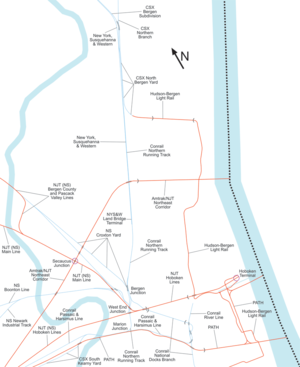Bergen Arches





Bergen Arches is an abandoned railroad right of way through Bergen Hill (the lower New Jersey Palisades) in Jersey City, New Jersey.
History[edit]
Bergen Arches is the common name for the Erie Cut, the Erie Railroad's mile-long, four-track cut which linked the railroad's main line to its Hudson River waterfront Pavonia Terminal, where travelers to Manhattan could transfer to the Pavonia Ferry or the Hudson and Manhattan Railroad.[1] From 1906 to 1910,[2] using 250,000 pounds of dynamite, workers blasted through 800,000 cubic yards (610,000 m3) of blue trap rock; 160,000 cubic yards (120,000 m3) of earth were excavated. There were construction cost overruns (and settlements paid to local homeowners for damage and injuries from flying rock), with a total cost around $5 million, that led to financial trouble for the Erie and the cancellation of plans to build a new terminal along the Jersey City waterfront.[3] The term "Bergen Arches" originally referred to the massive bridges over the cut, but the two terms have become synonymous.
The last trains to the terminal ran in 1957. The line was abandoned that year. The adjacent tunnel (the Long Dock Tunnel) from the mid-19th century that the Erie Cut replaced is used for freight, and is being restored as part of Liberty Corridor Project as an extension of National Docks Secondary line.
Future[edit]
Various projects have been proposed for the abandoned track bed: for a four-lane or six-lane highway that would connect the New Jersey Turnpike and U.S. Route 1/9 bypassing traffic headed along New Jersey Route 139 for the Holland Tunnel,[4] extension of the Hudson Bergen Light Rail, or in conjunction with the Harsimus Stem Embankment, a recreational greenway.
A freeway proposed in 1989 by Governor Thomas Kean[5] was strongly supported by then-Mayor Bret Schundler. In 1998, this project was allocated $26 million in the federal Transportation Equity Act for the 21st Century.[6][7] During the 2001 mayoral race, candidates instead lobbied for a mass transit line,[8] and in 2002 the plans were dropped during Mayor Cunningham's administration.[9] In that year, Parsons Brinckerhoff, a consulting firm, released another report commissioned by New Jersey Department of Transportation (NJDOT) and describing the conditions and analyzing of various options.[10][11] NJDOT has continued to fund studies for the project. In March 2011, an additional $13.4 million was allocated to advance the project.[12]
A Bergen Arches Preservation Coalition has proposed to run the East Coast Greenway through the Arches.[13][14]
See also[edit]
- List of bridges, tunnels, and cuts in Hudson County, New Jersey
- List of Erie Railroad structures documented by the Historic American Engineering Record
- Timeline of Jersey City area railroads
References[edit]
- ^ "New Erie Road Terminal" (PDF). The New York Times. March 31, 1903.
- ^ "Finish Erie Tunnel in Jersey Heights" (PDF). The New York Times. June 12, 1910.
- ^ "Jersey City History: The Bergen Arches of the Erie Railroad". The Jersey City Landmarks Conservancy. 2007. Archived from the original on January 30, 2011. Retrieved March 18, 2009.
- ^ "NJ 139 Freeway (Unbuilt)". nycroads.com.
- ^ Kerr, Peter (June 27, 1989). "Kean Proposes Transit Plan For Waterfront". The New York Times. Retrieved September 1, 2009.
- ^ "JERSEY PORTS:Newark-Jersey City projects". TollRoadsNews. July 4, 1998. Archived from the original on July 6, 2008. Retrieved September 1, 2009.
- ^ DiMaria, Paul (December 1, 1998). "Bergen Arches". Regional Transportation Advocate. Retrieved May 18, 2011.
- ^ "New Jersey City Mayor Could End Bergen Arches Highway Plan". Tri-State Transportation Campaign. May 28, 2001. Archived from the original on January 7, 2009. Retrieved September 1, 2009.
- ^ "Bergen Arches Concept Study Complete: Public Adamantly Opposes Roadway Option". Tri-State Transportation Campaign. October 28, 2002. Archived from the original on December 3, 2013. Retrieved September 1, 2009.
- ^ Parsons Brinckerhoff-FG, Inc. (September 2002). "Bergen Arches Study Final Report" (PDF). NJDOT. Retrieved May 19, 2011.
- ^ "Bergen Arches Study Overview". NJDOT. February 1, 2005. Retrieved May 18, 2011.
- ^ "Christie clears way for Hudson County transportation projects". Hudson Reporter. March 25, 2011. Archived from the original on May 16, 2013. Retrieved May 18, 2011.
- ^ "Bergen Arches Preservation Coalition". BAPC. Retrieved July 15, 2020.
- ^ Fry, Chris (July 9, 2020). "Jersey City's Bergen Arches Preservation Coalition Joins High Line Network". Jersey Digs. Retrieved August 10, 2020.
External links[edit]
- The Bergen Arches: A History - includes several photographs and classic postcards
- Bergen Arches roadway project
- Historic American Engineering Record (HAER) No. NJ-22, "Erie Railway, Bergen Hill Open Cut", 19 photos, 2 photo caption pages
- "Urban Enterprise Zone Five Year Strategic Plan; Transportation Infrastructure" (PDF). Jersey City Economic Development Corporation. p. 63. Archived from the original (PDF) on February 3, 2010. Retrieved June 11, 2009.
- State of New Jersey's study for possible other options for the Arches
- History, summary of road and rail options with an aerial picture of the arches and the nearby highways and railroads
- https://web.archive.org/web/20120929064726/http://www.njcu.edu/Programs/jchistory/Pages/B_Pages/Bergen_Arches.htm
- https://www.nj.com/news/2019/12/abandoned-rail-line-is-a-strange-urban-paradise-and-some-want-to-keep-it-that-way.html
- https://www.nj.com/hudson/2020/07/bergen-arches-preservation-coalition-joins-forces-with-high-line-network.html
- Transportation in Jersey City, New Jersey
- Geography of Hudson County, New Jersey
- Historic American Engineering Record in New Jersey
- Historic districts in Hudson County, New Jersey
- Erie Railroad
- Landforms of Hudson County, New Jersey
- Railroad tunnels in New Jersey
- Erie Railroad tunnels
- Tunnels in Hudson County, New Jersey
